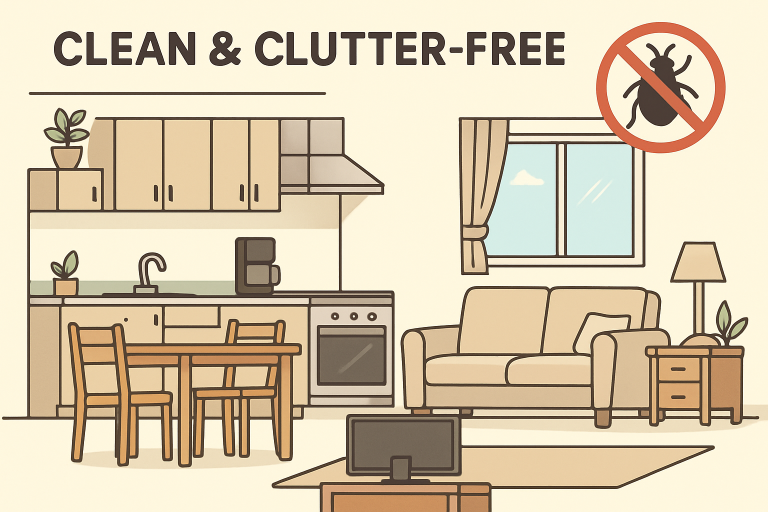Table of Contents
Key Takeaways
- Regular cleaning and home maintenance are crucial for preventing pest problems.
- Natural remedies offer eco-friendly alternatives for effective pest management.
- Sealing cracks and reducing food and water sources can significantly deter pests.
- Integrated Pest Management (IPM) promotes long-lasting, chemical-free protection.
Dealing with household pests is challenging for homeowners, and finding reliable solutions can be overwhelming. Fortunately, some methods protect your home and prioritize health and the environment. Using practical steps and safe products, you can stay pest-free without harsh chemicals. Homeowners in some areas also benefit from a professional exterminator who ensures safety and effectiveness.
Effective pest control starts with prevention and awareness. Regular maintenance and understanding pest habits can stop infestations early. Natural and eco-friendly methods are particularly helpful for families who avoid chemicals.
Regular inspections, sealing entry points, and natural repellents create an eco-friendly defense. Professionals can also provide tailored solutions to keep your home safe throughout the year.
For tough problems, a comprehensive pest control plan that utilizes multiple methods ensures effective and safe treatment for homes with children and pets.
Maintain A Clean & Clutter-Free Home
Cleanliness is your first and most effective defense against the most common pests. Daily cleaning habits eliminate food scraps, spills, and residues that attract insects and rodents. Pest control naturally starts with keeping your home tidy—pests crave dark, undisturbed, and cluttered spaces; these conditions also allow them to nest and breed undetected.
- Wipe kitchen counters and dining tables after each meal to remove crumbs and sticky spots.
- Vacuum floors, particularly corners and beneath appliances, to catch overlooked debris.
- Sort through and organize closets, basements, and attics to prevent packs of unused items from becoming pest harborage areas.
Additionally, regularly cleaning pet bowls, trash cans, and recycling bins further minimizes potential food sources for pests. Keeping your home tidy not only deters existing pests but also discourages new ones from settling in.

Seal Entry Points & Reduce Attractants
Small gaps and cracks in your home’s exterior or foundations can be all it takes for ants, spiders, or mice to gain entry. Inspect your home thoroughly—focus on doors, windows, plumbing fixtures, and other structural openings.
- Apply caulk or weatherstripping to seal even tiny openings around windows and doors.
- Repair loose screens and replace damaged weather seals.
- Store all grains, cereals, and sugar in airtight containers to prevent pantry pests.
- Fix leaking faucets and ensure proper drainage, as pests from infesting your food- and water-logged areas attract insects like mosquitoes and cockroaches.
A consistent effort to address entry points not only prevents pests but can also help improve your home’s overall energy efficiency.
Utilize Natural Pest Control Methods
Eco-friendly and non-toxic solutions can be highly effective in maintaining a pest-free household. Many families prefer natural deterrents and traps for their safety and environmental benefits.
- Essential oils, such as peppermint, eucalyptus, and tea tree oils, mixed with water, can repel ants, spiders, and even rodents. Spray along baseboards, entryways, and potential nesting sites.
- Diatomaceous Earth: This abrasive natural substance, when sprinkled in dark corners or beneath appliances, dehydrates and kills crawling insects without dangerous residues. Learn more about its safety from the EPA’s resource on diatomaceous earth.
- Homemade Traps: Simple traps made with common ingredients, such as vinegar or a sugar-borax mixture, can effectively catch and reduce populations of fruit flies and ants without the use of chemical baits.
Implement Integrated Pest Management (IPM)
Integrated pest management employs a comprehensive and sustainable approach by combining several strategies. The focus is on long-term prevention rather than short-term fixes. By monitoring, identifying pests, and intervening only when necessary, IPM minimizes risks to people and the environment. The U.S. Environmental Protection Agency provides additional details and tips about IPM principles and practices.
- Routine inspections and pest monitoring.
- Elimination of food, water, and habitat sources.
- Physical barriers and mechanical traps should be considered before resorting to chemical treatments.
- Applying natural or least-toxic products as a last measure, and only as needed.
Homes adopting IPM benefit from fewer infestations, reduced chemical exposure, and ongoing peace of mind.
Regular Inspections & Maintenance
Being vigilant pays off—regularly inspecting your living spaces allows you to catch early warning signs, such as droppings, gnawed fabric or packaging, unusual odors, or grease trails. Addressing these signs promptly prevents a minor issue from escalating into a larger, more costly problem.
When To Seek Professional Help
While DIY solutions are often sufficient for mild or seasonal concerns, more substantial infestations require expert knowledge and specialized equipment. Licensed pest control professionals can assess and address the root causes, ensuring a comprehensive and lasting solution tailored to your home’s specific needs.
Conclusion
A pest-free home is best achieved through a thoughtful blend of preventative practices, vigilance, and natural solutions wherever possible. Staying proactive with household maintenance, promptly addressing vulnerabilities, and using integrated and natural methods helps protect your health and property. When infestations do arise, don’t hesitate to consult a professional for a safe and comprehensive resolution.





No Comments